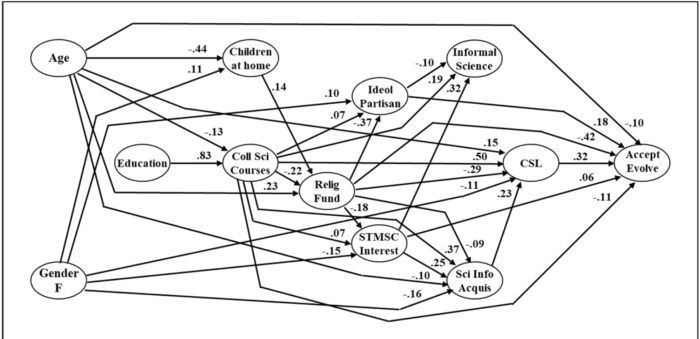Jul
13
2023
 It was recently revealed that the House subcommittee probing the origins of COVID-19 accidentally released a “trove” of documents related to their investigations. The documents include e-mails and internal communications among the scientists and experts who put together the first analysis of the proximal origin of SARS-CoV-2, published in Nature in March 2020. The documents reveal that there was a lot more discussion and credence given to the lab origin theory of SARS-CoV-2 in February 2020 than was reflected in the final published paper, which some see as evidence of a deliberate coverup. Further, because the documents are now publicly available, an army of online sleuths can pour over every word to find more evidence of something sinister.
It was recently revealed that the House subcommittee probing the origins of COVID-19 accidentally released a “trove” of documents related to their investigations. The documents include e-mails and internal communications among the scientists and experts who put together the first analysis of the proximal origin of SARS-CoV-2, published in Nature in March 2020. The documents reveal that there was a lot more discussion and credence given to the lab origin theory of SARS-CoV-2 in February 2020 than was reflected in the final published paper, which some see as evidence of a deliberate coverup. Further, because the documents are now publicly available, an army of online sleuths can pour over every word to find more evidence of something sinister.
Having looked through the reports myself, I don’t see anything unusual at all. Here is a typical exchange:
“I believe RaTG13 is from Yuanan, which is about as far away from Wuhan as you can be and still be in China,” Andersen wrote, referring to a virus that produced Covid-like symptoms in miners in 2013, a strain that was later stored and researched at the Wuhan Institute of Virology. “What are the chances of finding a viruses that are 96% identical given that distance? Seems strange given how many SARS-like viruses we have in bats.”
Rambaut responded on Slack suggesting they back off such interrogation. “I personally think we should get away from all the strange coincidence stuff. I agree it smells really fishy but without a smoking gun it will not do us any good,” he wrote. “The truth is never going to come out (if [lab] escape is the truth). Would need irrefutable evidence. My position is that the natural evolution is entirely plausible and we will have to leave it at that. Lab passaging might also generate this mutation but we have no evidence that that happened.”
These are scientists discussing through various possibilities. Remember, this was February 2020 – we knew virtually nothing about the virus, the origin of COVID, the source of the virus (we are still not sure about the animal vector), or what was happening at the Wuhan lab. We have the genetic sequence of the virus, that was it. You’ll note they are still talking about bats, a theory that was later refuted.
Continue Reading »
Jul
07
2023
 Are attitudes towards genetically modified organisms (GMOs) in our agriculture softening? Back in 2015 a Pew survey found that the gap between public opinion and that of scientists was greatest on acceptance of GMOs (more than any other topic surveyed), with a 51% gap. But more recent data shows declining opposition. Regulators are also softening their stance, with Mexico walking back a ban on GMO corn from the US, and the EU considering softer rules on GMOs. Some countries, like the US, have also adopted new terminology, such as bioengineered, and carved out separate rules for crops made with altered genes but not with transgene insertions.
Are attitudes towards genetically modified organisms (GMOs) in our agriculture softening? Back in 2015 a Pew survey found that the gap between public opinion and that of scientists was greatest on acceptance of GMOs (more than any other topic surveyed), with a 51% gap. But more recent data shows declining opposition. Regulators are also softening their stance, with Mexico walking back a ban on GMO corn from the US, and the EU considering softer rules on GMOs. Some countries, like the US, have also adopted new terminology, such as bioengineered, and carved out separate rules for crops made with altered genes but not with transgene insertions.
We still have a way to go, and there is still enough opposition to slow adoption of useful agricultural technology. I like to think this is because the science is slowly winning the day. I do think many environmentalists have their heart in the right place, but sometimes get distracted by ideological positions, such as an aversion to anything “unnatural” or high tech. But if the stakes get high enough, the more moderate environmentalists can change their position. I think we are seeing this with nuclear power and the need to combat global warming. And I think we are seeing this with GMOs and the need to feed the world without destroying the environment. The benefits of GMOs are ultimately just too great to ignore.
But there is a lot of inertia in the anti-GMO propaganda that Greenpeace, the organic lobby, and others have been spreading for two decades. I was just recently asked about one specific claim that reflects the nature of this propaganda and how sticky it can be – aren’t GMOs killing the butterflies? The short answer is no, but as always the full story has lots of details. Here is a typical headline from the Environmental Working Group (who I personally find to be more ideological than science-based) – GMO-Linked Herbicide May Doom Monarch Butterflies. This framing was lazily reproduced by most mainstream reporting, but it is nothing but anti-GMO propaganda.
Continue Reading »
Jun
23
2023

RFK Jr., who is now running for the Democratic presidential nomination, is anti-vaccine. He will vehemently deny this, but I don’t buy it for a second. He is simply playing the, “I’m not anti-vaccine, I am pro-safe vaccine” gambit, which is disingenuous and always has been. We have been covering this topic for years, and David Gorski did a recent excellent review of this at SBM. You can’t claim not to be anti-vaccine, and then defend a long list of anti-vaccine tropes.
RFK has apparently been avoiding his views on vaccines on the campaign trail, but it always seems to come up. On the Joe Rogan podcast RFK found what he must have thought was a friendly environment, and felt free to repeat is claim that vaccine cause autism. This is a topic I have been covering for two decades – vaccines do not cause autism. But let’s do a quick review of this harmful claim.
This first appeared in the 1990, when the anti-vaccine movement hit upon the increase in autism diagnoses as a new tactic. They start with the assumption that all bad things that happen to children are caused by vaccines, so obviously they must also be causing the rise in autism. When Andrew Wakefield came out with his fraudulent and now retracted study claiming an association between the MMR vaccine and autism, he became an instant celebrity of the anti-vaccine movement. Trouble is – the MMR vaccine does not cause autism. Wakefield, it turns out, had a patent on an alternative vaccine and was trying to torpedo the competition. But the anti-vaccine movement does not let science, evidence, or basic logic get in their way. So they simply moved over to a vaccine ingredient, thimerosal, which is a mercury-based preservative.
Continue Reading »
Oct
25
2022
 At a recent talk, during the Q&A an audience member asked me what I thought the consequences would be of the “idiocracy” we seem to be heading toward. I challenged the premise, that people in general are becoming less intelligent. I know it may superficially seem like this, but that has more to do with media savvy, echochambers, tribalism, and radicalization, not any demonstrable decline in raw intelligence.
At a recent talk, during the Q&A an audience member asked me what I thought the consequences would be of the “idiocracy” we seem to be heading toward. I challenged the premise, that people in general are becoming less intelligent. I know it may superficially seem like this, but that has more to do with media savvy, echochambers, tribalism, and radicalization, not any demonstrable decline in raw intelligence.
In fact, I pointed out, in the last century there has been a consistent increase in IQ testing ability, by about 3 IQ points per decade (called the Flynn Effect). There is still debate about what this means, and it is important to point out that IQ testing does not equal “intelligence” which is multifaceted. But whatever standard IQ tests are measuring, performance is generally improving over time. Another measure, that of civic scientific literacy (in a longstanding series of studies by Jon Miller), increased from 1988 t0 2008 from 9% to 29%. It has since plateaued at that level.
There is no consensus as to why this is so, but I have some thoughts based on the literature. Technology is exposing people to more information, and this has only been increasing further with the advent of computers, the internet, and even social media. Regardless of any negative effects, people seem to know more stuff, and have improved problem-solving skills. Our brains are busier, they are exposed to more ideas and facts, we interact with a greater number of different people and opinions, and we have to interface with technology and information more. The workforce is shifting from manual labor to more intellectual labor. Even just going through your normal day likely involves interacting with technology that would have befuddled older generations.
Continue Reading »
Oct
07
2022
 At this point there is little question that a giant asteroid, 10 kilometers across, impacted the Earth about 66 million years ago. Evidence for this impact began with an iridium layer discovered at the Cretaceous-Paleogene, or K-Pg, boundary. Something deposited an unusually high level of iridium in a brief event all around the world. Later the likely crater resulting from this impact was found in Chicxulub, Mexico. Multiple other discoveries have supported this conclusion, including the fact that this impact was the likely cause of the dinosaur extinction. There was also massive volcanic activity at that time, and dinosaur populations may have been in decline, but that was likely a side show. The main event was the impact.
At this point there is little question that a giant asteroid, 10 kilometers across, impacted the Earth about 66 million years ago. Evidence for this impact began with an iridium layer discovered at the Cretaceous-Paleogene, or K-Pg, boundary. Something deposited an unusually high level of iridium in a brief event all around the world. Later the likely crater resulting from this impact was found in Chicxulub, Mexico. Multiple other discoveries have supported this conclusion, including the fact that this impact was the likely cause of the dinosaur extinction. There was also massive volcanic activity at that time, and dinosaur populations may have been in decline, but that was likely a side show. The main event was the impact.
Such an impact would have released a tremendous amount of energy (10^23 joules), equivalent to a 100 million megaton bomb. There were multiple effects of that impact. One is that a lot of Earth crust material would have been melted and thrown up into the atmosphere, but at less than escape velocity so ultimately raining back down to Earth. Some of these molten droplets cooled into glass spherules as they fell, raining tiny glass beads onto the Earth – creating another geological marker for the impact.
The asteroid impact was essentially in the Gulf of Mexico, causing a massive tsunami that swept over North America. My favorite geological find resulting from this is at the Tanis site in Hell’s Creek. The massive tsunami washed lots of fish and other sea life across the continent, and deposited them in a valley, creating a large jumble of fossils all deposited at once. Scientists know they are from the day of the impact because the fish have glass spherules stuck in their gills – they breathed them in while still alive.
Continue Reading »
Jan
03
2022
 Whether or not natural gas power and nuclear power plants should be considered “green” (meaning that they are environmentally friendly) is not just an abstract question. The European Commission has proposed plans to label some (emphasis on some) gas and nuclear plants as officially green. This has real-world consequences, such as the ability to receive funding and whether or not they will be considered green financial investments.
Whether or not natural gas power and nuclear power plants should be considered “green” (meaning that they are environmentally friendly) is not just an abstract question. The European Commission has proposed plans to label some (emphasis on some) gas and nuclear plants as officially green. This has real-world consequences, such as the ability to receive funding and whether or not they will be considered green financial investments.
Part of the purpose of the proposal is to keep companies from “greenwashing” their portfolio and business activities, by listing which investments are considered officially green (as opposed to ones that may be presented as environmentally friendly when they are not). This proposal, however, has sparked a controversy of its own, with some EU countries, such as Germany, claiming that the proposed rules are a form of greenwashing themselves. Other countries, like France, who depend on nuclear power for 70% of their energy, have pushed for such labeling. Who has the better argument?
Let’s take each technology unto itself, because they really are independent and don’t necessarily have to be taken as a package. Natural gas is a fossil fuel, and burning natural gas for energy does release CO2 into the atmosphere. The supply of natural gas is also increasingly dependent on fracking technology, which injects air and liquids into fossil fuel deposits in order to liberate and gain access to natural gas. This technology has significantly brought down the price of natural gas, resulting in a surge of its use in some countries. This surge has mostly displaced the burning of coal for power, and that is exactly the reason why some believe the technology should be considered green – in comparison to this one alternative.
Continue Reading »
Aug
26
2021
 The idea that all life on Earth is related through a nested hierarchy of branching evolution, occurring over billions of years through entirely natural processes, is one of the biggest ideas ever to emerge from human science. It did not just emerge whole cloth from the brain of Charles Darwin, it had been percolating in the scientific community for decades. Darwin, however, put it all together in one long compelling argument. Alfred Wallace independently came up with essentially the same conclusion, although did not develop it as far as Darwin.
The idea that all life on Earth is related through a nested hierarchy of branching evolution, occurring over billions of years through entirely natural processes, is one of the biggest ideas ever to emerge from human science. It did not just emerge whole cloth from the brain of Charles Darwin, it had been percolating in the scientific community for decades. Darwin, however, put it all together in one long compelling argument. Alfred Wallace independently came up with essentially the same conclusion, although did not develop it as far as Darwin.
On the Origin of Species was published in 1859, and it quickly won over the scientific community, with natural selection acting on variation becoming the dominant working hypothesis. But that, of course, was not the end of the story, only the beginning. If Darwin’s ideas were wrong, they would have slowly withered from lack of confirming evidence. But they were largely correct, even insightful. The last 162 years of research and observation have confirmed to an extraordinary degree the core ideas that life is related through branching connections, and that natural selection is a primary driving force of evolution. The theory has also evolved quite a bit, and is now a mature and complex scientific discipline sitting on top of mountains of evidence, including fossils, genetics, comparative anatomy, developmental biology, and direct observation. The basic fact of evolution could have been falsified thousands of times over, but it has survived every time – because it is essentially true.
Acceptance of the basic tenets of evolutionary theory, therefore, is a good litmus test for any modern society. Of what, exactly, is another question, but certainly something is going wrong if the population does not accept this overwhelming scientific consensus. The US ranks second from the bottom (only Turkey is worse) in terms of accepting evolutionary theory. Researchers have been tracking the statistics for decades, and now some of the lead researchers in this field have published data from 1985 to 2020 (sorry it’s behind a paywall). There are some interesting details to pull from the numbers.
Continue Reading »
Feb
16
2021
 Before around 13,000 years ago large mammals walked North America – the Mammoth, most famously, but also giant beavers, giant tree sloths, glyptodonts, and the American cheetah among them. By around 11,000 years ago they were all gone (38 genera, mostly mammals). Extinction is a natural part of the cycle of ecosystems, and no species lasts forever. But when paleontologists identify a pulse of extinctions, above the background rate, they call that an extinction event, and this definitely qualifies. Extinction events call out for answers – what was the cause?
Before around 13,000 years ago large mammals walked North America – the Mammoth, most famously, but also giant beavers, giant tree sloths, glyptodonts, and the American cheetah among them. By around 11,000 years ago they were all gone (38 genera, mostly mammals). Extinction is a natural part of the cycle of ecosystems, and no species lasts forever. But when paleontologists identify a pulse of extinctions, above the background rate, they call that an extinction event, and this definitely qualifies. Extinction events call out for answers – what was the cause?
In the case of the North American megafauna extinction, there are two main hypotheses. The first is the overkill hypothesis – that the extinction coincides with the arrival of paleoindians on the continent, and that is not likely a coincidence. Generally speaking the arrival of humans into any ecosystem correlates with a pulse of extinctions. Perhaps the humans taking up residence in North America were big-game hunters, and the megafauna could not adapt quickly enough to this clever predator.
The second major hypothesis is that climatic change was the major cause. The last major glacial period lasted from 125,000 to 14,900 years ago, and then started the current interglacial period (the holocene) that we are in. However, this warming was interrupted in North American by the Younger Dryas, a cold snap that lasted from 12,900 to 10,600 years ago. The cause of this cold spell is also a controversy, with the two main hypotheses being a local comet impact vs the effects of major glacial melt on ocean currents. Either way, by the time the cold snap was over, the megafauna was gone.
Continue Reading »
Nov
10
2020
 A new game called Harmony Square was released today. The game hires you, the player, as a Chief Disinformation Officer, and then walks you through a campaign to cause political chaos in this otherwise placid town. The game is based upon research showing that exposing people to the tactics of disinformation “inoculates” them against similar tactics in the real world. The study showed, among other things, that susceptibility to fake news headlines declined by 21% after playing the game. Here is the full abstract:
A new game called Harmony Square was released today. The game hires you, the player, as a Chief Disinformation Officer, and then walks you through a campaign to cause political chaos in this otherwise placid town. The game is based upon research showing that exposing people to the tactics of disinformation “inoculates” them against similar tactics in the real world. The study showed, among other things, that susceptibility to fake news headlines declined by 21% after playing the game. Here is the full abstract:
The spread of online misinformation poses serious challenges to societies worldwide. In a novel attempt to address this issue, we designed a psychological intervention in the form of an online browser game. In the game, players take on the role of a fake news producer and learn to master six documented techniques commonly used in the production of misinformation: polarisation, invoking emotions, spreading conspiracy theories, trolling people online, deflecting blame, and impersonating fake accounts. The game draws on an inoculation metaphor, where preemptively exposing, warning, and familiarising people with the strategies used in the production of fake news helps confer cognitive immunity when exposed to real misinformation. We conducted a large-scale evaluation of the game with N = 15,000 participants in a pre-post gameplay design. We provide initial evidence that people’s ability to spot and resist misinformation improves after gameplay, irrespective of education, age, political ideology, and cognitive style.
While encouraging, I think there are some caveats to the current incarnations of this approach. But first, let me say that I think the concept is solid. The best way to understand mechanisms of deception and manipulation is to learn how to do them yourself. This is similar to the old adage – you can’t con a con artist. I think “can’t” is a little strong, but the idea is that someone familiar with con artist techniques is more likely to spot them in others. Along similar lines, there is a strong tradition of skepticism among professional magicians. They know how to deceive, and will spot others using similar deceptive techniques. (The famous rivalry between James Randi and Uri Geller is a good example of this.)
Continue Reading »
Oct
22
2020
 Over the course of the pandemic the death rate in people diagnosed with COVID-19 (the case-fatality rate) has declined. Unpacking all the reasons this may be the case can help us better understand and fight this disease. A few recent studies shed some light on this question. While there might be some encouraging news here, it highlights that this is still a “novel” virus and we have a lot to learn about the illness it causes.
Over the course of the pandemic the death rate in people diagnosed with COVID-19 (the case-fatality rate) has declined. Unpacking all the reasons this may be the case can help us better understand and fight this disease. A few recent studies shed some light on this question. While there might be some encouraging news here, it highlights that this is still a “novel” virus and we have a lot to learn about the illness it causes.
One recent study looking at the case fatality rate in the New York region from March to August found that the death rate for those admitted to the hospital dropped from 27% to 3%. They also found many possible reasons for this dramatic decrease. One is the fact that in March New York hospitals were overwhelmed with COVID cases. They did not have enough ICU beds or ventilators, and doctors were crushed beneath the initial wave of cases of a disease they had no experience with. So simply “flattening the curve” and reducing pressure on hospitals is one important factor.
The most encouraging reason for the decline is the steep learning curve of knowing how to treat those who are seriously ill with COVID. Doctors have learned through direct experience how to better manage COVID patients, and many interventions became standard practice between March and August. For example, it is better to rest patients on their stomach than their back, and it is better to delay ventilation as long as possible. The discovery that steroids can reduce the risk of cytokine storm was perhaps a significant improvement. Some patients now get convalescent plasma, something that obviously could not have happened early on. Remdesevir was given emergency use authorization, but a recent study by the WHO found no survival benefit from this drug (or from hydroxychloroquine, a combination of the anti-HIV drugs lopinavir and ritonavir; and interferon).
While we still do not have a cure for COVID-19 or a proven effective anti-viral, management has significantly improved and this has definitely contributed to survival. However – this is not the only effect, and may not even be the major effect.
Continue Reading »
 It was recently revealed that the House subcommittee probing the origins of COVID-19 accidentally released a “trove” of documents related to their investigations. The documents include e-mails and internal communications among the scientists and experts who put together the first analysis of the proximal origin of SARS-CoV-2, published in Nature in March 2020. The documents reveal that there was a lot more discussion and credence given to the lab origin theory of SARS-CoV-2 in February 2020 than was reflected in the final published paper, which some see as evidence of a deliberate coverup. Further, because the documents are now publicly available, an army of online sleuths can pour over every word to find more evidence of something sinister.
It was recently revealed that the House subcommittee probing the origins of COVID-19 accidentally released a “trove” of documents related to their investigations. The documents include e-mails and internal communications among the scientists and experts who put together the first analysis of the proximal origin of SARS-CoV-2, published in Nature in March 2020. The documents reveal that there was a lot more discussion and credence given to the lab origin theory of SARS-CoV-2 in February 2020 than was reflected in the final published paper, which some see as evidence of a deliberate coverup. Further, because the documents are now publicly available, an army of online sleuths can pour over every word to find more evidence of something sinister.
 Are attitudes towards genetically modified organisms (GMOs) in our agriculture softening? Back in 2015
Are attitudes towards genetically modified organisms (GMOs) in our agriculture softening? Back in 2015 
 At a recent talk, during the Q&A an audience member asked me what I thought the consequences would be of the “idiocracy” we seem to be heading toward. I challenged the premise, that people in general are becoming less intelligent. I know it may superficially seem like this, but that has more to do with media savvy, echochambers, tribalism, and radicalization, not any demonstrable decline in raw intelligence.
At a recent talk, during the Q&A an audience member asked me what I thought the consequences would be of the “idiocracy” we seem to be heading toward. I challenged the premise, that people in general are becoming less intelligent. I know it may superficially seem like this, but that has more to do with media savvy, echochambers, tribalism, and radicalization, not any demonstrable decline in raw intelligence. At this point there is little question that a giant asteroid, 10 kilometers across, impacted the Earth about 66 million years ago. Evidence for this impact began with an iridium layer discovered at the Cretaceous-Paleogene, or K-Pg, boundary. Something deposited an unusually high level of iridium in a brief event all around the world. Later the likely crater resulting from this impact was found in Chicxulub, Mexico. Multiple other discoveries have supported this conclusion, including the fact that this impact was the likely cause of the dinosaur extinction. There was also massive volcanic activity at that time, and dinosaur populations may have been in decline, but that was likely a side show. The main event was the impact.
At this point there is little question that a giant asteroid, 10 kilometers across, impacted the Earth about 66 million years ago. Evidence for this impact began with an iridium layer discovered at the Cretaceous-Paleogene, or K-Pg, boundary. Something deposited an unusually high level of iridium in a brief event all around the world. Later the likely crater resulting from this impact was found in Chicxulub, Mexico. Multiple other discoveries have supported this conclusion, including the fact that this impact was the likely cause of the dinosaur extinction. There was also massive volcanic activity at that time, and dinosaur populations may have been in decline, but that was likely a side show. The main event was the impact. Whether or not natural gas power and nuclear power plants should be considered “green” (meaning that they are environmentally friendly) is not just an abstract question. The
Whether or not natural gas power and nuclear power plants should be considered “green” (meaning that they are environmentally friendly) is not just an abstract question. The  The idea that all life on Earth is related through a nested hierarchy of branching evolution, occurring over billions of years through entirely natural processes, is one of the biggest ideas ever to emerge from human science. It did not just emerge whole cloth from the brain of Charles Darwin, it had been percolating in the scientific community for decades. Darwin, however, put it all together in one long compelling argument. Alfred Wallace independently came up with essentially the same conclusion, although did not develop it as far as Darwin.
The idea that all life on Earth is related through a nested hierarchy of branching evolution, occurring over billions of years through entirely natural processes, is one of the biggest ideas ever to emerge from human science. It did not just emerge whole cloth from the brain of Charles Darwin, it had been percolating in the scientific community for decades. Darwin, however, put it all together in one long compelling argument. Alfred Wallace independently came up with essentially the same conclusion, although did not develop it as far as Darwin. Before around 13,000 years ago
Before around 13,000 years ago  A new game called
A new game called  Over the course of the pandemic the death rate in people diagnosed with COVID-19 (the case-fatality rate) has declined. Unpacking all the reasons this may be the case can help us better understand and fight this disease. A few recent studies shed some light on this question. While there might be some encouraging news here, it highlights that this is still a “novel” virus and we have a lot to learn about the illness it causes.
Over the course of the pandemic the death rate in people diagnosed with COVID-19 (the case-fatality rate) has declined. Unpacking all the reasons this may be the case can help us better understand and fight this disease. A few recent studies shed some light on this question. While there might be some encouraging news here, it highlights that this is still a “novel” virus and we have a lot to learn about the illness it causes.




